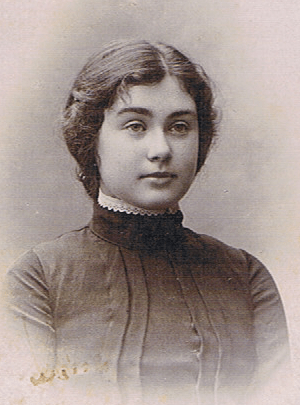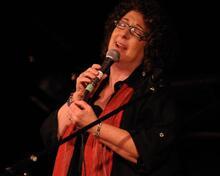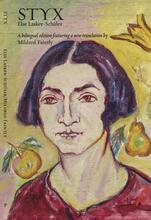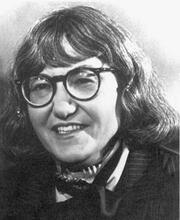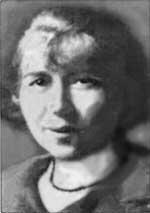Anna Margolin
Rosa Lebensboim, known as Anna Margolin in 1903. Critics claim she authored the finest Yiddish poetry of the early twentieth century.
Image courtesy of Wikimedia Commons
Born in Lithuania, Anna Margolin immigrated to New York in 1906, where she joined a circle of Jewish immigrant intellectuals. Margolin became a professional journalist for the Yiddish press and began writing a weekly women’s column for Der Tog, becoming a member of their editorial board in 1920. She adopted the pseudonym Anna Margolin and published all her poetry under that name. Margolin’s poetry, which literary critics rank among the finest Yiddish poetry of early twentieth-century America, reveals her as a literary modernist with a secular perspective. In 1929 Margolin published Lider, a volume of eighty poems in which she reflects on her feelings of isolation as a woman and a foreigner. In 1932, Margolin published her last poems, spending the final years of her life as a recluse.
Rosa Lebensboim, better known by her pen name of Anna Margolin, is regarded by literary critics as one of the finest early twentieth-century Yiddish poets in America. Her poetry, translated by Adrienne Rich, Kathryn Hellerstein, and Marcia Falk, among others, appears in many Yiddish poetry anthologies in English. Captivating, temperamental, and intellectually gifted, Anna Margolin influenced the work of several major writers and thinkers of her time.
Early Life & Immigration to New York
Anna Margolin was born in the Lithuanian town of Brisk on January 21, 1887, the only child of Dvoyre Leye (Rosenblum) and Menachem Lebensboim, who turned from Hasidism to a more worldly way of life. Under her father’s guidance, Margolin received a European secular education. As a child, she lived briefly in Königsberg and Odessa, later moving to Warsaw, where her father resided after her parents’ divorce. In 1906, her father sent her to America, where she began her writing career.
In New York, she joined the circle of immigrant Jewish intellectuals who gathered around the Yiddishist Chaim Zhitlovsky. Zhitlovsky was influenced by Margolin, both personally and intellectually, and engaged her as his secretary. Margolin’s new connections, in addition to her sharp wit and original writing talent, opened many doors for her, and she soon became a professional journalist for the Yiddish press. Her first piece of fiction appeared in the Fraye Arbeter Shtime, and she joined its editorial staff for six months.
Marriage, Upheaval, & Return to New York
Restless, Margolin traveled to London, Paris, and back to Warsaw, where she met the Hebrew writer Moshe Stavski and married him. Together they moved to Palestine, where her only child, Naaman, was born. Unhappy in her marriage and stifled by the lack of intellectual stimulation in small-town Tel Aviv, Margolin returned to Warsaw, leaving behind her husband and infant son. In the spring of 1913, she moved to New York, making it her permanent home.
Upon her return to the United States, she joined the staff of the newly established daily Der Tog in 1914, and became a member of the editorial board until 1920. At Der Tog, she wrote a weekly women’s column entitled “In der Froyen Velt” [In the women’s world] and traveled in Europe as a correspondent reporting on women’s issues. During this time, she wrote several articles supporting the suffrage movement.
In the offices of Der Tog, Margolin met her second husband, Hirsh Leib Gordon. When Gordon left for service in World War I, they became estranged, and Margolin became involved with Yiddish writer Reuben Iceland. Iceland was instrumental in encouraging her writing of poetry, and Margolin, in turn, had an impact on his writing. They became lifelong companions.
Margolin’s Poetry
Margolin used many pen names during her writing career. Beginning in 1909, she wrote short stories under the names Khave Gros and Khane Barut. She signed some of her journalistic work as Sofia Brandt and later as Clara Lenin. When she began to publish poems in the early 1920s, she used the pseudonym Anna Margolin, and then published all her poetry under this name.
Although her first poems appeared in politically radical papers, she did not limit herself to the politics of one newspaper or to the journals of one literary group. She was published in Di Naye Velt, Fraye Arbeter Shtime, Nay Yidish, In Zikh, and Tzukunft. Her themes were personal, yet intellectual and unsentimental. Margolin’s poetry reveals her as a literary modernist with a secular perspective.
In 1923, Margolin edited a poetry anthology entitled Dos Yidishe Lid in Amerika, which showcased the best Yiddish contemporary poetry. It included a broad range of writers from both opposing Yiddish literary groups of the time—Di Yunge and the more contemporary Inzikhistn [Introspectivists]—as well as others.
In 1929, eighty of Margolin’s poems were published in a volume entitled Lider. In this collection, she examined her relationship with Reuben Iceland, as well as her feelings of isolation as a foreigner and as a woman. In America, her book did not receive the acclaim she had anticipated, but in Warsaw, important critics wrote about her work with enthusiasm.
End of Life
After the publication of Lider, Margolin had six poems published and then became silent. Her last poems appeared in 1932. Although she continued to write, she no longer allowed her works to be published. By age fifty, she suffered from severe depression and chronic minor ailments. For the final years of her life, Margolin became a recluse.
Her epitaph, which she wrote herself years before her death, is a lament for a squandered life. Yet in her short writing career, and with only one volume of poetry published, she became the toast of the Yiddish literati and gained wide recognition for her unique poems.
Anna Margolin died on June 29, 1952, in New York.
Selected Works
Anna Margolin: Poems. Edited by Abraham Novershtern Jerusalem: Magnes, 1991
Drunk From the Bitter Truth: The Poems of Anna Margolin. Translated by Shirley Kumove. New York: SUNY Press, 2005
Editor. Dos Yidishe Lid in Amerika—1923: Antologye. New York: N.p., 1923
Lider. New York: N.p., 1929
Brenner, Naomi. “Slippery Selves: Rachel Bluvstein and Anna Margolin in Poetry and in Public.” Nashim: A Journal of Jewish Women’s Studies & Gender Issues no. 19 (Spring 2010): 100-133.
Cooper, Adrienne. “About Anna Margolin.” In The Tribe of Dina: A Jewish Women’s Anthology, edited by Melanie Kaye/Kantrowitz and Irene Klepfisz. Boston: Beacon Press, 1989
Cooperman, Jehiel and Sarah Cooperman, editors. America in Yiddish Poetry. New York: Exposition Press 1967
Howe, Irving, and Eliezer Greenberg, editors. A Treasury of Yiddish Poetry. New York: Schocken Books, 1976
Howe, Irving, Ruth R. Wisse, and Khone Shmeruk, editors. The Penguin Book of Modern Yiddish Verse. New York: Penguin, 1987
Iceland, Reuben. Fun Unzer Friling [Of our springtime] (1954)
Leksikon fun der Nayer Yidisher Literatur [Biographic dictionary of modern Yiddish literature]. Vol. 5 (1963): 478–480
Novershtern, Abraham. “‘Who Would Have Believed that a Bronze Statue Can Weep?’: The Poetry of Anna Margolin.” Introduction to Anna Margolin: Poems. Jerusalem: Magnes, 1991 1991
Pratt, Norma Fain. “Anna Margolin’s Lider: A Study in Women’s History, Autobiography, and Poetry.” Studies in American Jewish Literature 3 (1983): 11–25
Pratt, Norma Fain. “Culture and Radical Politics: Yiddish Women Writers, 1890–1940.” American Jewish History 70, no. 1 (September 1980): 68–90
Richter, Lisa. Nautilus and Bone: An Auto/biography in Poems. Calgary: Frontenac House, 2020.

